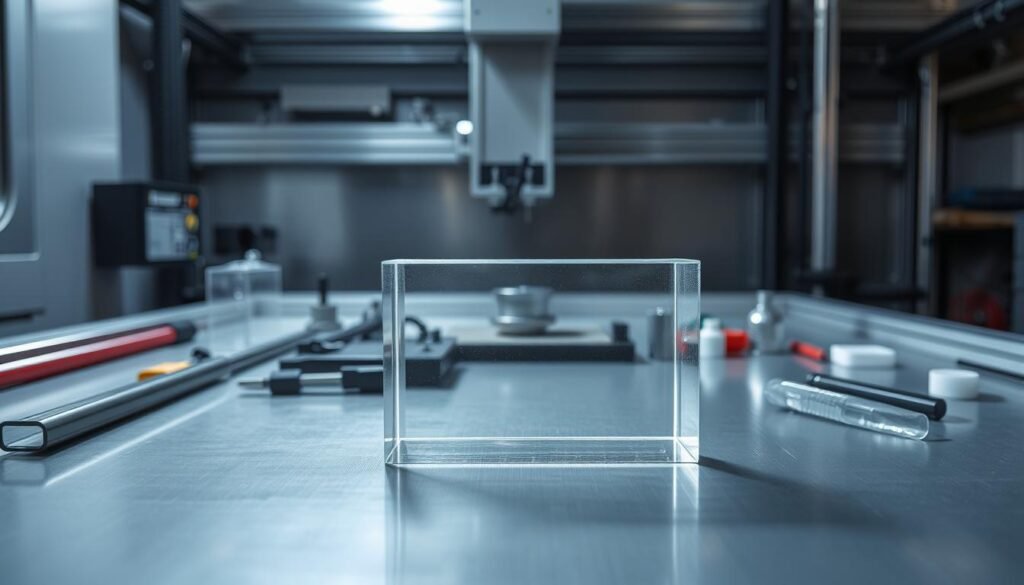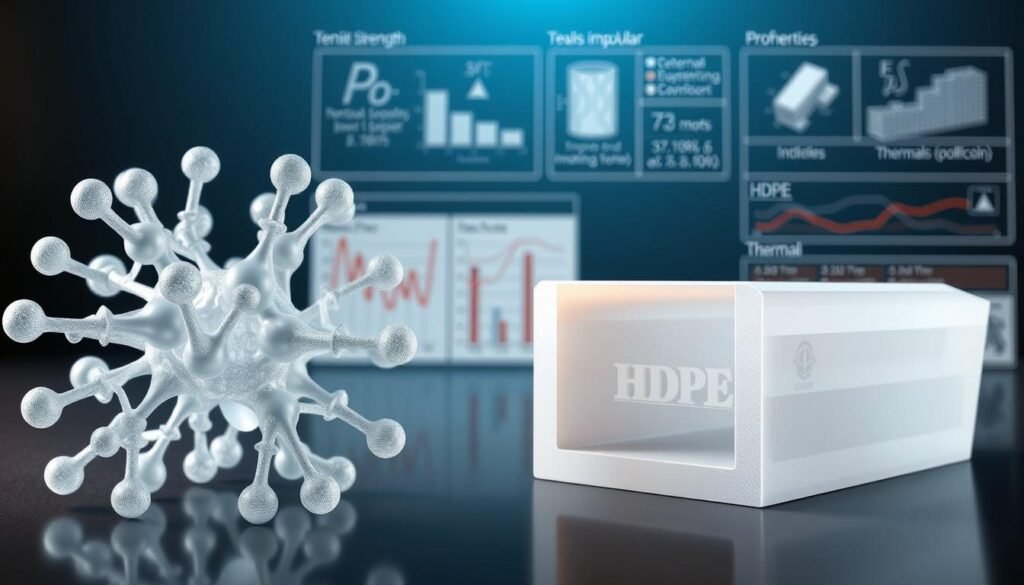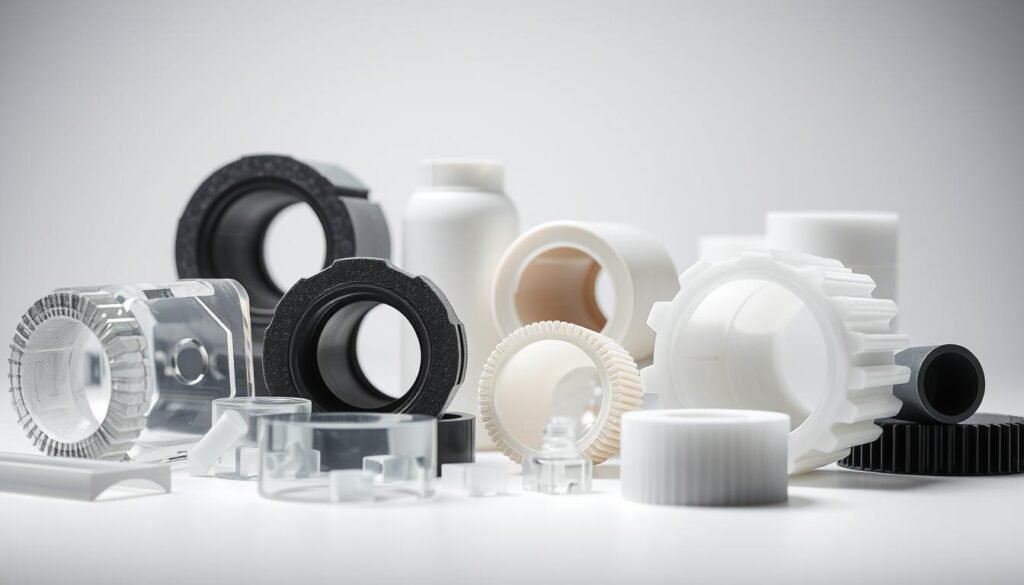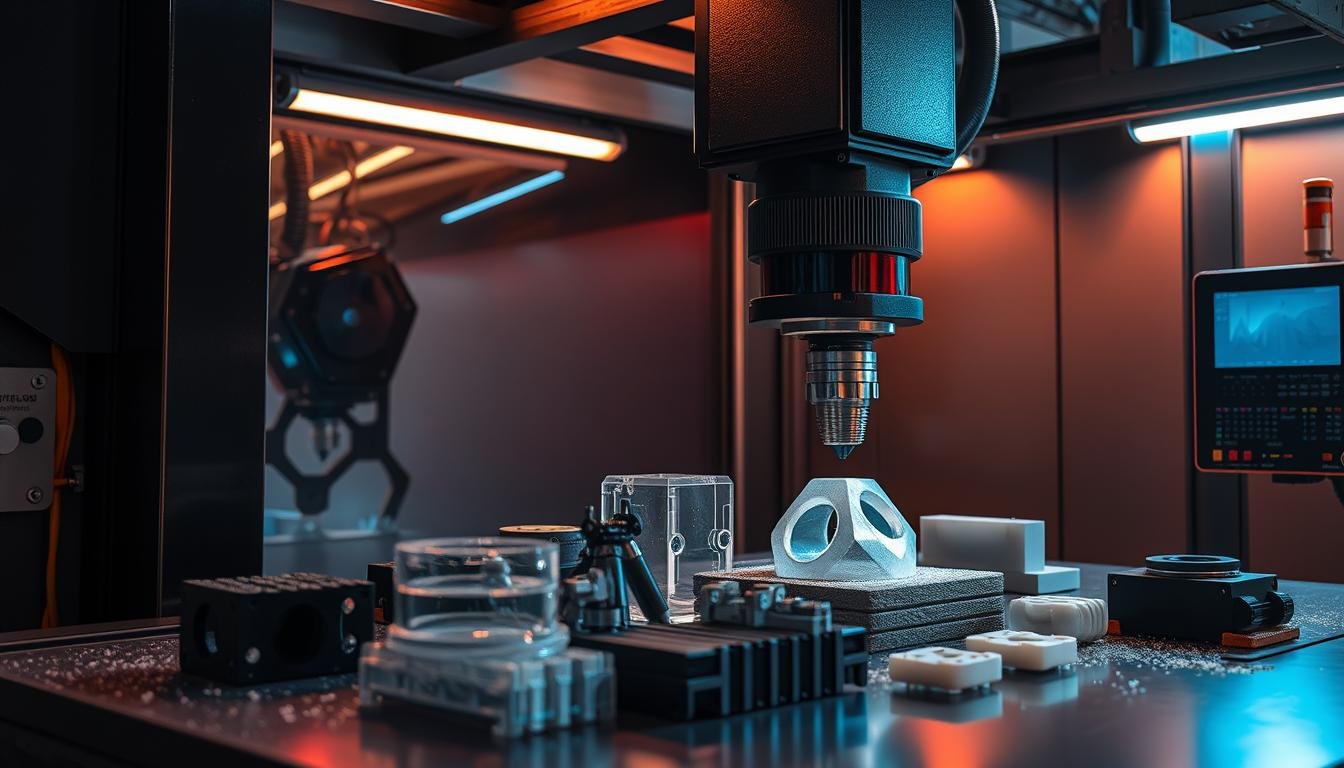На сайте Обработка на станках с ЧПУ, choosing the right plastic materials is key. This article looks at ABS, Polyoxymethylene (POM), and Нейлон. We explore their special features and uses. This helps professionals in точное производство make better choices.
Knowing about these plastics can improve product quality and performance. It’s important for many industries.
Основные выводы
- The selection of plastic materials significantly impacts Обработка на станках с ЧПУ результаты.
- ABS is favored for its durability and versatility in various applications.
- POM provides superior mechanical properties, making it ideal for precision parts.
- Нейлон is known for its toughness and flexibility, with extensive uses in manufacturing.
- Understanding each material’s properties is essential for optimal изготовление на заказ.
- Informed выбор материала can lead to enhanced product performance and reliability.
Introduction to CNC Machining and Plastic Materials
Обработка на станках с ЧПУ has changed the manufacturing world. It brings precision and efficiency to many areas. This method uses computers to control machines, making detailed designs from different materials, like plastics.
Plastic machining is popular because plastics are light and versatile. They are also cheaper than metals in many cases. This makes plastics a good choice for many projects.
Plastics are changing many industries. They offer new ways to design and make products. Knowing about the strengths and uses of plastics is key in CNC machining.
Understanding the Importance of Material Selection
When starting CNC machining, выбор материала is key. Different materials have unique properties like strength and hardness. These properties help them last longer under stress.
Steel and titanium are great for heavy tasks because they are strong and last long. They are perfect for jobs that need a lot of power.
Choosing materials that are good for the environment is also important. Using recyclable materials helps protect our planet. Aluminum is a good choice because it’s light and doesn’t rust easily.
Materials that meet environmental rules are better for business. They show that a company cares about the planet. This makes the company look good.
How well a material handles heat is also important. Some materials stay strong even when it’s hot or cold. Titanium and special alloys are great for this.
When picking materials, think about what the project needs. For things that get very hot, titanium or special alloys are good. For things that need to be light, aluminum or plastics might be better.
It’s also important to think about how materials react to chemicals. Some materials can’t handle chemicals well. This can make them break down over time.
Stainless steel is good for places where things might rust. It’s used in medical stuff, boats, and places that make food. Plastics like PEEK and PTFE are also good for places with chemicals.
Overview of ABS as a CNC Machining Material
ABS, or Acrylonitrile Butadiene Styrene, is a top choice for CNC machining. It has special properties that make it good for many uses. Knowing about ABS helps when picking materials.
Properties of ABS
ABS has strong mechanical properties important for CNC machining. Key ABS properties включают:
- Impact Resistance: ABS is tough under stress, great for tough jobs.
- Toughness: It can handle pressure well, making products last longer.
- Обрабатываемость: ABS is easy to work with, leading to precise and efficient CNC work.
Advantages and Disadvantages of Using ABS
ABS has many good points for makers:
- Affordability: It’s cheaper than many other materials.
- Универсальность: It can be shaped into complex forms, useful in many fields.
But, there are some downsides:
- Poor Chemical Resistance: ABS can’t handle some chemicals, limiting its use.
- Less Heat Resistant: It can warp at high temperatures, so it needs careful use in hot places.
Common Applications for ABS
ABS is used in many areas, showing its value:
- Electronic Enclosures: It protects electronics well because of its toughness.
- Prototyping: Its easy machining makes quick prototypes possible, speeding up design work.
- Consumer Goods: Toys and home items often use ABS for its strength and looks.
Exploring Polyoxymethylene (POM) and Its Advantages

Polyoxymethylene, or POM, is a material with many benefits. It has strong mechanical properties like tensile strength and rigidity. Its low friction surface makes it great for engineering needs.
Mechanical and Thermal Properties of POM
POM has amazing mechanical properties for many uses. It has:
- High tensile strength and stiffness
- Excellent dimensional stability
- Low moisture absorption
- Good chemical resistance
- Outstanding wear resistance
It also stays stable in heat, making it useful in different places. This makes POM better than other materials.
POM vs. Nylon: A Comparative Analysis
Глядя на POM vs. Nylon, each has its own strengths and weaknesses. Here’s what we find:
| Недвижимость | POM | Нейлон |
|---|---|---|
| Прочность на разрыв | Высокий | Умеренный |
| Moisture Absorption | Низкий | Высокий |
| Износостойкость | Превосходно | Хорошо |
| Chemical Resistance | Хорошо | Умеренный |
Нейлон is better for flexibility and resilience. But POM is best for things that need to hold a lot of weight and have low friction.
Applications and Industries Utilizing POM
POM is used in many places because of its benefits. It’s used in:
- Automotive parts like gears and bushings
- Consumer goods like appliances and tools
- Industrial parts for precision
- Medical devices needing to be strong and safe
POM is a key material in today’s making things. It meets the needs of many industries for quality and dependability.
The Versatility of Nylon in CNC Machining
Nylon is very popular in CNC machining because it’s so versatile. It’s strong and useful for many things. Knowing what makes Nylon great helps us use it well in making things.
Key Properties and Benefits of Nylon
Nylon is loved for many reasons. It’s strong and can handle moisture well. This makes it great for many uses.
- High toughness: Nylon is very strong and can handle tough jobs.
- Moisture absorption: It can soak up moisture, which helps it stay strong in wet places.
- Chemical resistance: Nylon can stand up to many chemicals, making it useful in many places.
Nylon is also light, flexible, and easy to shape. These qualities make it perfect for detailed designs. All these benefits mean Nylon works well in many areas.
Challenges When Using Nylon
But, using Nylon can be tricky. Some common problems are:
- Warping: Changes in temperature can cause it to warp.
- Tool wear: Nylon can wear down tools fast.
- Moisture management: Keeping moisture levels right is key to avoiding problems.
Overcoming these issues is important for making sure products are good and last long.
Typical Applications for Nylon in Industry
Nylon is great for many uses because of its special qualities. It’s often used for:
- Car parts like gears and bearings.
- Medical tools and prosthetics.
- Parts for planes where being light and strong matters.
These examples show how well Nylon works in different fields. It’s a top pick for CNC machining.
Acrylic: The Optical Plastic Choice for CNC Machining

Acrylic is known for its clear look and strong build. It’s a top pick for places that need clear and pretty materials. We’ll look at what makes Acrylic great for CNC machining and its many uses.
Properties that Make Acrylic Unique
Сайт Acrylic properties stand out because of:
- High optical clarity, letting light pass through like glass.
- Great scratch resistance, keeping it looking good for a long time.
- It’s light, making it easy to move and put up compared to glass.
- Low thermal expansion, keeping its shape in different temperatures.
Common Uses for Acrylic in Machining
Сайт uses of Acrylic cover many fields because of its good looks. Some key uses are:
| Промышленность | Приложение |
|---|---|
| Автомобили | Interior parts, lenses, and displays |
| Архитектура | Windows, skylights, and signs |
| Optical | Glasses, optical tools, and lights |
| Retail | Displays, barriers, and sales items |
| Медицина | Glasses, shields, and medical tools |
Polycarbonate: The Strong and Impact-Resistant Plastic
Polycarbonate is a very strong material. It’s often picked for many uses because it’s impact resistant. It’s durable and can handle tough jobs.
Key Features of Polycarbonate
Some key polycarbonate features это:
- It can handle high temperatures well.
- It’s resistant to chemicals, lasting longer.
- It’s very impact resistant, not breaking easily.
These traits make polycarbonate great for tough jobs. It’s perfect for safety glasses, electronic parts, and protective shields.
Applications and Limitations of Polycarbonate
Polycarbonate is used in many fields. It’s found in:
- Car parts, keeping drivers safe and visible.
- Windows, making buildings more energy-efficient.
- Police gear, protecting officers without weighing them down.
But, polycarbonate has some downsides. It can scratch easily and is hard to machine. Handling it right is key to keeping it strong.
For more info on polycarbonate’s benefits and uses, check out этот ресурс.
The Role of High-Density Polyethylene (HDPE) in CNC Machining

High-Density Polyethylene (HDPE) is key in CNC machining. It’s known for its properties and flexibility. HDPE can handle tough chemicals and lasts long in different conditions. It’s a top choice for makers.
Properties and Benefits of HDPE
HDPE has special qualities that make it popular in machining:
- Mechanical Strength: HDPE is strong and reliable.
- Chemical Resistance: It stands up well to many chemicals, great for industrial use.
- Ease of Fabrication: HDPE is easy to work with, speeding up production.
- Эффективность затрат: It’s cheaper than other plastics but still performs well.
Common Applications and Industries for HDPE
HDPE is used in many fields, showing its wide range of uses:
- Packaging: It’s in containers and bottles because it resists chemicals.
- Construction: Used for pipes and geomembranes, adding strength.
- Automotive: In car parts for being light and strong.
- Consumer Goods: In toys and home items, safe and durable.
Thin Metal Sheet Fabrication: Integrating Plastic and Metal Components
Thin metal sheet fabrication is key in today’s making. It makes it easy to mix plastic and metal parts. This method is precise, making sure both parts work well together.
It makes products stronger and saves money in making them.
Characteristics of Thin Metal Sheet Fabrication
Thin metal sheet fabrication has special traits for many uses. Key features include:
- Accuracy: It’s very precise, thanks to new machine tools.
- Универсальность: It can make many shapes and sizes, fitting different needs.
- Lightweight: Thin materials make products lighter, which is good for cars and planes.
- Эффективность затрат: It cuts down on waste and costs, using resources better.
How CNC Machined Plastics Work with Metal Components
Adding plastics to thin metal sheets makes products better. CNC machines make metal parts precise. CNC machined plastics add special benefits:
- Enhanced Design Flexibility: Designers can use different materials for complex shapes.
- Weight Optimization: Mixing light plastic with strong metal makes designs better.
- Improved Aesthetics: Plastics offer many finishes, improving looks and function.
By planning well, makers can use thin metal sheet fabrication and CNC machined plastics. This mix leads to better products. It’s why this method is getting more popular in many fields.
Other Notable Plastic Materials Used in CNC Machining

In CNC machining, many plastics are used, not just the usual ones. Each plastic has special qualities that make it good for different jobs. Knowing about plastics like polypropylene, PTFE, and UHMW can help pick the right one for engineering tasks.
Understanding the Benefits of Additional Plastics
More plastics bring big advantages to making things. Here are some main benefits:
- Полипропилен: It’s light and resists chemicals well. It’s great for storage and car parts.
- PTFE: It doesn’t stick and can handle high heat. It’s good for places where sticking and heat are issues.
- UHMW: It’s tough against wear and tear and has low friction. It’s used in conveyor belts and liners.
Applications for Other Plastics in Manufacturing
More plastics are used in many areas. Here are some common uses:
| Тип пластика | Общие приложения |
|---|---|
| Полипропилен | Packaging, textiles, automotive parts |
| PTFE | Gaskets, seals, cookware |
| UHMW | Medical equipment, food processing, material handling |
Choosing the Right Material for Your CNC Project
Choosing the right plastic for CNC projects is important. You need to think about many things. Things like how strong the plastic is, what it’s used for, and how it affects the environment and your budget.
Knowing these things helps make sure the plastic you pick fits your project’s needs. It also makes sure it meets industry standards.
Factors to Consider When Selecting a Plastic Material
When picking plastic, there are a few main things to think about:
- Mechanical Properties: The plastic’s strength, flexibility, and durability must match the project’s needs.
- Compatibility: The plastic must work well with other materials in the project.
- Processing Requirements: Different plastics need different CNC machining techniques.
Environmental and Cost Considerations
Cost is a big factor in choosing plastic. You should think about the upfront cost and how sustainable the plastic is in the long run. The воздействие на окружающую среду of plastic is also very important today.
Things like if the plastic can be recycled or broken down naturally are key. Finding a balance between cost and being eco-friendly is good for your project and the planet.
Заключение
We’ve looked at CNC plastics like ABS, POM, and Nylon. We’ve seen how each material is special and where it’s used. Knowing these details is key to making smart choices.
Choosing the right material is very important. It affects how well your product works, lasts, and costs. The right pick can make a big difference.
Looking ahead, CNC machining will keep getting better. New plastics and ways to make them are coming. This means we can make even better products.
By keeping up with these changes, we can do great work. We’ll make sure our projects are top-notch. This is how we stay ahead in a tough market.
ЧАСТО ЗАДАВАЕМЫЕ ВОПРОСЫ
What are the benefits of using ABS in CNC machining?
ABS is strong, tough, and affordable. It’s great for many uses. It also has good impact resistance and is easy to machine. But, it can’t handle chemicals well.
How does POM compare to Nylon in CNC machining?
POM is very strong and has a low friction surface. It’s good for carrying heavy loads. Compared to Nylon, POM is more rigid and absorbs less moisture.
What challenges are associated with machining Nylon?
Nylon is tough and resistant to chemicals. But, it can warp and wear down tools. This makes machining it tricky.
Why is Acrylic a popular choice for CNC machining?
Acrylic is clear and scratch-resistant. It’s perfect for things that need to look good and be transparent. It’s used in cars and glasses.
What are the key properties of Polycarbonate?
Polycarbonate is very strong against impacts and heat. It also resists chemicals well. But, it can scratch easily.
How does High-Density Polyethylene (HDPE) contribute to CNC machining?
HDPE is cheap, strong, and resistant to chemicals. It’s used in packaging and building. It’s also easy to work with.
What techniques are involved in thin metal sheet fabrication?
Making thin metal sheets requires precise methods. These methods combine metal and plastic well. They make sure the product looks and works great.
What are some notable plastics used in CNC machining apart from ABS, POM, and Nylon?
Other important plastics are polypropylene, PTFE, and UHMW. Each has its own benefits and uses. They help solve different engineering problems.
How do environmental and cost factors influence material selection in CNC projects?
Choosing materials for CNC projects involves many factors. You need to think about strength, cost, and how it affects the environment. It’s important to find materials that meet needs without breaking the bank or harming the planet.


